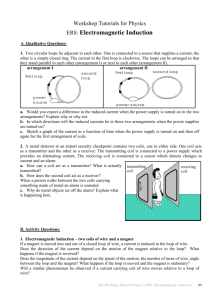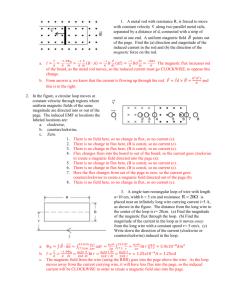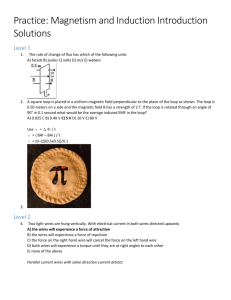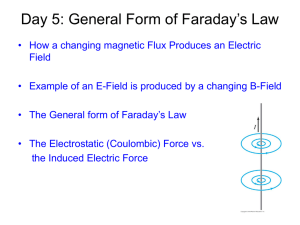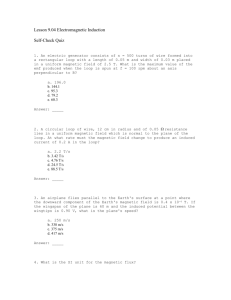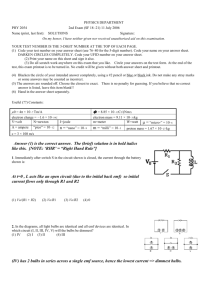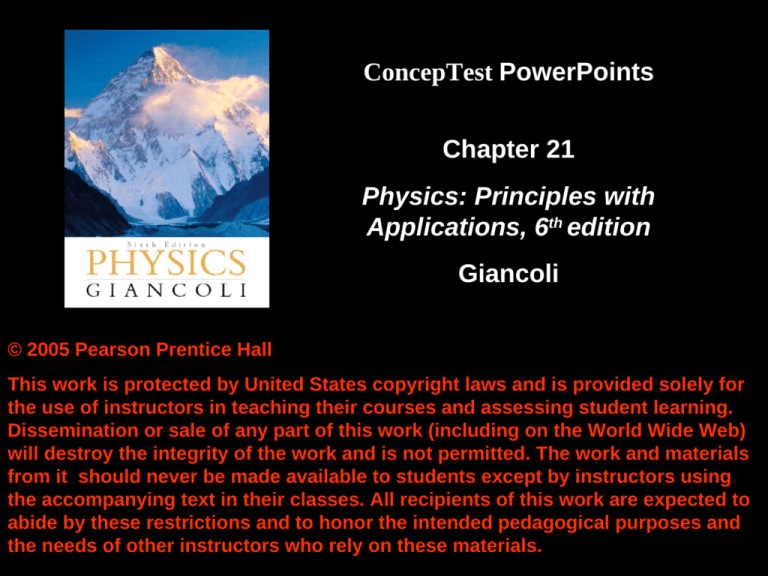
ConcepTest PowerPoints
Chapter 21
Physics: Principles with
Applications, 6th edition
Giancoli
© 2005 Pearson Prentice Hall
This work is protected by United States copyright laws and is provided solely for
the use of instructors in teaching their courses and assessing student learning.
Dissemination or sale of any part of this work (including on the World Wide Web)
will destroy the integrity of the work and is not permitted. The work and materials
from it should never be made available to students except by instructors using
the accompanying text in their classes. All recipients of this work are expected to
abide by these restrictions and to honor the intended pedagogical purposes and
the needs of other instructors who rely on these materials.
ConcepTest 21.1a Magnetic Flux I
In order to change the
magnetic flux through
the loop, what would
you have to do?
1) drop the magnet
2) move the magnet upwards
3) move the magnet sideways
4) only (1) and (2)
5) all of the above
ConcepTest 21.1a Magnetic Flux I
In order to change the
magnetic flux through
the loop, what would
you have to do?
1) drop the magnet
2) move the magnet upwards
3) move the magnet sideways
4) only (1) and (2)
5) all of the above
Moving the magnet in any direction would
change the magnetic field through the
loop and thus the magnetic flux.
ConcepTest 21.1b Magnetic Flux II
1) tilt the loop
In order to change the
2) change the loop area
magnetic flux through
3) use thicker wires
the loop, what would
4) only (1) and (2)
you have to do?
5) all of the above
ConcepTest 21.1b Magnetic Flux II
1) tilt the loop
In order to change the
2) change the loop area
magnetic flux through
3) use thicker wires
the loop, what would
4) only (1) and (2)
you have to do?
5) all of the above
Since Φ = B A cosθ , changing the
area or tilting the loop (which varies
the projected area) would change
the magnetic flux through the loop.
ConcepTest 21.2a Moving Bar Magnet I
If a North pole moves toward the
1) clockwise
loop from above the page, in what
2) counterclockwise
direction is the induced current?
3) no induced current
ConcepTest 21.2a Moving Bar Magnet I
If a North pole moves toward the
1) clockwise
loop from above the page, in what
2) counterclockwise
direction is the induced current?
3) no induced current
The magnetic field of the moving bar
magnet is pointing into the page and
getting larger as the magnet moves
closer to the loop. Thus the induced
magnetic field has to point out of the
page.
page A counterclockwise induced
current will give just such an induced
magnetic field.
Follow-up: What happens if the magnet is stationary but the loop moves?
ConcepTest 21.2b Moving Bar Magnet II
If a North pole moves toward
1) clockwise
the loop in the plane of the
2) counterclockwise
page, in what direction is the
3) no induced current
induced current?
ConcepTest 21.2b Moving Bar Magnet II
If a North pole moves toward
1) clockwise
the loop in the plane of the
2) counterclockwise
page, in what direction is the
3) no induced current
induced current?
Since the magnet is moving parallel
to the loop, there is no magnetic
flux through the loop.
loop Thus the
induced current is zero.
zero
ConcepTest 21.3a Moving Wire Loop I
A wire loop is being pulled
through a uniform magnetic
field. What is the direction
of the induced current?
1) clockwise
2) counterclockwise
3) no induced current
x x x x x x x x x x x
x
x x x x x x x x x x x
x
x x x x x x x x x x x
x
x x x x x x x x x x x
x
x x x x x x x x x x x
x
ConcepTest 21.3a Moving Wire Loop I
A wire loop is being pulled
through a uniform magnetic
field. What is the direction
of the induced current?
1) clockwise
2) counterclockwise
3) no induced current
x x x x x x x x x x x
x
Since the magnetic field is uniform, the
magnetic flux through the loop is not
changing.
changing Thus no current is induced.
induced
x x x x x x x x x x x
x
x x x x x x x x x x x
x
x x x x x x x x x x x
x
x x x x x x x x x x x
x of the
Follow-up: What happens if the loop moves out
ConcepTest 21.3b Moving Wire Loop II
A wire loop is being pulled
through a uniform magnetic
field that suddenly ends.
What is the direction of the
induced current?
x x x x x
x x x x x
x x x x x
x x x x x
x x x x x
x x x x x
1) clockwise
2) counterclockwise
3) no induced current
ConcepTest 21.3b Moving Wire Loop II
A wire loop is being pulled
through a uniform magnetic
field that suddenly ends.
What is the direction of the
1) clockwise
2) counterclockwise
3) no induced current
induced current?
x x x x x
The B field into the page is disappearing in
x x x x x
the loop, so it must be compensated by an
induced flux also into the page.
page This can
x x x x x
be accomplished by an induced current in
x x x x x
the clockwise direction in the wire loop.
x x x x x
x x x x x
Follow-up: What happens when the loop is completely
x x xout
x of
x the field?
ConcepTest 21.3c Moving Wire Loop III
What is the direction of the
induced current if the B field
suddenly increases while the
loop is in the region?
x x x
x
x x x
x x x
x
x x x
x x x
x
x x x
x x x
x x x
x
x x x
x x x
x xx x
1) clockwise
2) counterclockwise
3) no induced current
x x x x x x x x
x x
x x x x x x x x
x x
x x x x x x x x
x x
x x x x x x x x
x x
x x
x x x x x x x x
x x
x x x x x x x x x x x
ConcepTest 21.3c Moving Wire Loop III
What is the direction of the
induced current if the B field
suddenly increases while the
loop is in the region?
1) clockwise
2) counterclockwise
3) no induced current
x x x x x x x x x x x
x
x x x x x
must be countered by an induced
x x x x x x x x x x x
x
flux out of the page.
page This can be
x x x x x
x x x x x x x x x x x
accomplished by induced current
x
x
x
x x x
in the counterclockwise direction
x x x x x x x x x x x
x x x x x
x
in the wire loop.
x x x x x
x x x x x x x x x x x
x xx xthe
x xfield increases?
Follow-up: What if the loop stops moving while
The increasing B field into the page
ConcepTest 21.4 Shrinking Wire Loop
If a coil is shrinking in a
1) clockwise
magnetic field pointing into
2) counterclockwise
the page, in what direction
3) no induced current
is the induced current?
ConcepTest 21.4 Shrinking Wire Loop
If a coil is shrinking in a
1) clockwise
magnetic field pointing into
2) counterclockwise
the page, in what direction
3) no induced current
is the induced current?
The magnetic flux through the loop is
decreasing,
decreasing so the induced B field must
try to reinforce it and therefore points in
the same direction — into the page.
page
According to the right-hand rule, an
induced clockwise current will generate
a magnetic field into the page.
page
Follow-up: What if the B field is oriented at 90° to its present direction?
ConcepTest 21.5 Rotating Wire Loop
If a coil is rotated as shown,
1) clockwise
in a magnetic field pointing
2) counterclockwise
to the left, in what direction
3) no induced current
is the induced current?
ConcepTest 21.5 Rotating Wire Loop
If a coil is rotated as shown,
1) clockwise
in a magnetic field pointing
2) counterclockwise
to the left, in what direction
3) no induced current
is the induced current?
As the coil is rotated into the B field,
the magnetic flux through it increases.
increases
According to Lenz’s Law, the induced
B field has to oppose this increase,
increase
thus the new B field points to the right.
right
An induced counterclockwise current
produces just such a B field.
ConcepTest 21.6a Voltage and Current I
Wire #1 (length L) forms a one-turn loop,
and a bar magnet is dropped through.
Wire #2 (length 2L) forms a two-turn loop,
and the same magnet is dropped through.
Compare the magnitude of the induced
voltages in these two cases.
1) V1 > V2
2) V1 < V2
3) V1 = V2 ≠ 0
4) V1 = V2 = 0
S
S
N
N
ConcepTest 21.6a Voltage and Current I
Wire #1 (length L) forms a one-turn loop,
and a bar magnet is dropped through.
Wire #2 (length 2L) forms a two-turn loop,
and the same magnet is dropped through.
Compare the magnitude of the induced
voltages in these two cases.
Faraday’s law:
ε = −N ∆∆Φt
1) V1 > V2
2) V1 < V2
3) V1 = V2 ≠ 0
4) V1 = V2 = 0
B
depends on N (number of loops)
loops
so the induced emf is twice as
large in the wire with 2 loops.
loops
S
S
N
N
ConcepTest 21.6b Voltage and Current II
Wire #1 (length L) forms a one-turn loop,
and a bar magnet is dropped through.
Wire #2 (length 2L) forms a two-turn loop,
and the same magnet is dropped through.
Compare the magnitude of the induced
currents in these two cases.
1) I1 > I2
2) I1 < I2
3) I1 = I2 ≠ 0
4) I1 = I2 = 0
S
S
N
N
ConcepTest 21.6b Voltage and Current II
Wire #1 (length L) forms a one-turn loop,
and a bar magnet is dropped through.
Wire #2 (length 2L) forms a two-turn loop,
and the same magnet is dropped through.
Compare the magnitude of the induced
currents in these two cases.
Faraday’s law:
1) I1 > I2
2) I1 < I2
3) I1 = I2 ≠ 0
4) I1 = I2 = 0
ε = −N ∆∆Φt
B
says that the induced emf is twice
as large in the wire with 2 loops.
loops
The current is given by Ohm’s law:
I = V/R.
V/R Since wire #2 is twice as
long as wire #1, it has twice the
resistance,
resistance so the current in both
wires is the same.
S
S
N
N
ConcepTest 21.7a Falling Magnet I
A bar magnet is held above the floor
and dropped. In 1, there is nothing
between the magnet and the floor.
In 2, the magnet falls through a
copper loop. How will the magnet in
1) it will fall slower
2) it will fall faster
3) it will fall the same
case 2 fall in comparison to case 1?
S
S
N
N
copper
loop
ConcepTest 21.7a Falling Magnet I
A bar magnet is held above the floor
and dropped. In 1, there is nothing
between the magnet and the floor.
In 2, the magnet falls through a
copper loop. How will the magnet in
1) it will fall slower
2) it will fall faster
3) it will fall the same
case 2 fall in comparison to case 1?
When the magnet is falling from above
the loop in 2, the induced current will
produce a North pole on top of the loop,
loop
which repels the magnet.
When the magnet is below the loop, the
induced current will produce a North
pole on the bottom of the loop,
loop which
attracts the South pole of the magnet.
S
S
N
N
copper
loop
Follow-up: What happens in case 2 if you flip the magnet
so that the South pole is on the bottom as the magnet falls?
ConcepTest 21.7b Falling Magnet II
If there is induced
current, doesn’t
that cost energy?
Where would that
energy come from
in case 2?
1) induced current doesn’t need any energy
2) energy conservation is violated in this case
3) there is less KE in case 2
4) there is more gravitational PE in case 2
S
S
N
N
copper
loop
ConcepTest 21.7b Falling Magnet II
If there is induced
current, doesn’t
that cost energy?
Where would that
energy come from
in case 2?
1) induced current doesn’t need any energy
2) energy conservation is violated in this case
3) there is less KE in case 2
4) there is more gravitational PE in case 2
In both cases, the magnet starts with
the same initial gravitational PE.
In case 1, all the gravitational PE has
been converted into kinetic energy.
In case 2, we know the magnet falls
slower, thus there is less KE.
KE The
difference in energy goes into making
the induced current.
current
S
S
N
N
copper
loop
ConcepTest 21.8a Loop and Wire I
A wire loop is being pulled away
from a current-carrying wire.
What is the direction of the
induced current in the loop?
I
1) clockwise
2) counterclockwise
3) no induced current
ConcepTest 21.8a Loop and Wire I
A wire loop is being pulled away
from a current-carrying wire.
What is the direction of the
induced current in the loop?
The magnetic flux is into the page on the
right side of the wire and decreasing due
to the fact that the loop is being pulled
away. By Lenz’s Law, the induced B field
will oppose this decrease.
decrease Thus, the new
B field points into the page, which
requires an induced clockwise current to
produce such a B field.
1) clockwise
2) counterclockwise
3) no induced current
I
ConcepTest 21.8b Loop and Wire II
What is the induced current if
1) clockwise
the wire loop moves in the
2) counterclockwise
direction of the yellow arrow ?
3) no induced current
I
ConcepTest 21.8b Loop and Wire II
What is the induced current if
1) clockwise
the wire loop moves in the
2) counterclockwise
direction of the yellow arrow ?
3) no induced current
The magnetic flux through the loop
is not changing as it moves parallel
to the wire. Therefore, there is no
induced current.
current
I
ConcepTest 21.9 Motional EMF
A conducting rod slides on a
conducting track in a constant
1) clockwise
B field directed into the page.
2) counterclockwise
What is the direction of the
3) no induced current
induced current?
x x x x x x x x x x x
x x x x x x x x x x x
x x x x x x x x x x x
x x x x x x x x x x x
v
ConcepTest 21.9 Motional EMF
A conducting rod slides on a
conducting track in a constant
1) clockwise
B field directed into the page.
2) counterclockwise
What is the direction of the
3) no induced current
induced current?
The B field points into the page.
page
The flux is increasing since the
area is increasing. The induced
B field opposes this change and
therefore points out of the page.
page
Thus, the induced current runs
counterclockwise according to
the right-hand rule.
x x x x x x x x x x x
x x x x x x x x x x x
x x x x x x x x x x x
v
x x x x x x x x x x x
Follow-up: What direction is the magnetic force on the rod as it moves?
ConcepTest 21.10 Generators
A generator has a coil of wire
rotating in a magnetic field.
If the rotation rate increases,
1) increases
2) decreases
how is the maximum output
3) stays the same
voltage of the generator
4) varies sinusoidally
affected?
ConcepTest 21.10 Generators
A generator has a coil of wire
rotating in a magnetic field.
If the rotation rate increases,
1) increases
2) decreases
how is the maximum output
3) stays the same
voltage of the generator
4) varies sinusoidally
affected?
The maximum voltage is the
leading term that multiplies sin(ω t)
and is given by ε 0 = NBAω .
Therefore, if ω increases,
increases then ε 0
must increase as well.
ε = NBAω sin(ωt )
ConcepTest 21.11 Magic Loop
A wire loop is in a uniform
(1) moves to the right
magnetic field. Current flows
(2) moves up
in the wire loop, as shown.
(3) remains motionless
What does the loop do?
(4) rotates
(5) moves out of the page
ConcepTest 21.11 Magic Loop
A wire loop is in a uniform
(1) moves to the right
magnetic field. Current flows
(2) moves up
in the wire loop, as shown.
(3) remains motionless
What does the loop do?
(4) rotates
(5) moves out of the page
There is no magnetic force on the top
and bottom legs, since they are parallel
to the B field. However, the magnetic
force on the right side is into the page,
page
and the magnetic force on the left side
is out of the page.
page Therefore, the
entire loop will tend to rotate.
This is how a motor works !!
ConcepTest 21.12a Transformers I
1) 30 V
What is the voltage
2) 60 V
across the lightbulb?
3) 120 V
4) 240 V
5) 480 V
120 V
ConcepTest 21.12a Transformers I
1) 30 V
What is the voltage
2) 60 V
across the lightbulb?
3) 120 V
4) 240 V
5) 480 V
The first transformer has a 2:1 ratio
of turns, so the voltage doubles.
doubles
But the second transformer has a
1:2 ratio,
ratio so the voltage is halved
again. Therefore, the end result is
the same as the original voltage.
voltage
120 V
240 V
120 V
ConcepTest 21.12b Transformers II
1) 1/4 A
Given that the intermediate
2) 1/2 A
current is 1 A, what is the
3) 1 A
current through the
4) 2 A
lightbulb?
5) 5 A
1A
120 V
240 V
120 V
ConcepTest 21.12b Transformers II
1) 1/4 A
Given that the intermediate
2) 1/2 A
current is 1 A, what is the
3) 1 A
current through the
4) 2 A
lightbulb?
5) 5 A
Power in = Power out
240 V × 1 A = 120 V × ???
1A
The unknown current is 2 A.
A
120 V
240 V
120 V
ConcepTest 21.12c Transformers III
A 6 V battery is connected to
one side of a transformer.
Compared to the voltage drop
across coil A, the voltage
2) 6 V
3) less than 6 V
4) zero
across coil B is:
A
6V
1) greater than 6 V
B
ConcepTest 21.12c Transformers III
A 6 V battery is connected to
1) greater than 6 V
one side of a transformer.
2) 6 V
Compared to the voltage drop
3) less than 6 V
across coil A, the voltage
4) zero
across coil B is:
The voltage across B is zero.
zero
Only a changing magnetic flux
induces an EMF. Batteries can
only provide DC current.
current
A
6V
B



